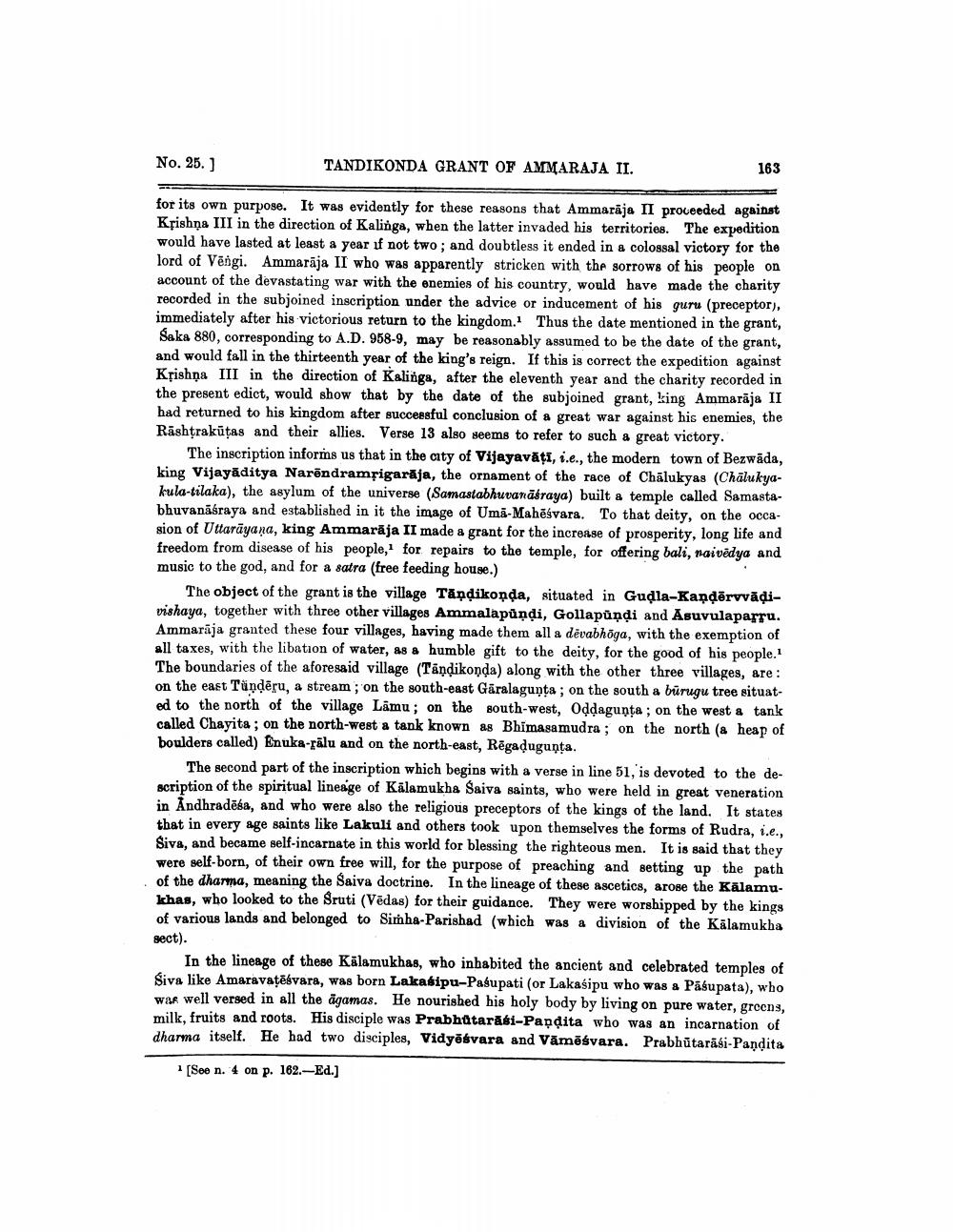________________
No. 25.)
TANDIKONDA GRANT OF AMMARAJA II.
163
for its own purpose. It was evidently for these reasons that Ammarāja II proceeded against Krishna III in the direction of Kalinga, when the latter invaded his territories. The expedition would have lasted at least a year if not two; and doubtless it ended in a colossal victory for the lord of Vēngi. Ammarāja II who was apparently stricken with the sorrows of his people on account of the devastating war with the enemies of his country, would have made the charity recorded in the subjoined inscription under the advice or inducement of his guru (preceptor), immediately after his victorious return to the kingdom. Thus the date mentioned in the grant, Saka 880, corresponding to A.D. 958-9, may be reasonably assumed to be the date of the grant, and would fall in the thirteenth year of the king's reign. If this is correct the expedition against Kțishņa III in the direction of Kalinga, after the eleventh year and the charity recorded in the present edict, would show that by the date of the subjoined grant, Ling Ammarāja II had returned to his kingdom after successful conclusion of a great war against his enemies, the Rashtrakūtas and their allies. Verse 13 also seems to refer to such a great victory.
The inscription informs us that in the city of Vijayavāți, i.e., the modern town of Bezwāda, king Vijayāditya Narēndramrigarāja, the ornament of the race of Chalukyas (Chalukyakula-tilaka), the asylum of the universe (Samastabhuvanäsraya) built a temple called Samastabhuvanāśraya and established in it the image of Umā-Mahēšvara. To that deity, on the occasion of Uttarayana, king Ammarāja II made a grant for the increase of prosperity, long life and freedom from disease of his people, for repairs to the temple, for offering bali, naivedya and music to the god, and for a satra (free feeding house.)
The object of the grant is the village Tāņdikonda, situated in Gudla-Kandērvvāļivishaya, together with three other villages Ammalapündi, Gollapundi and Asuvulaparru. Ammarāja granted these four villages, having made them all a dēvabhöga, with the exemption of all taxes, with the libation of water, as a humble gift to the deity, for the good of his people.
The boundaries of the aforesaid village (Tändikonda) along with the other three villages, are : on the east Tündéru, a stream; on the south-east Gāralagunta, on the south a burugu tree situated to the north of the village Lāmu; on the south-west, Oddagunța; on the west a tank called Chayita; on the north-west a tank known as Bhimasamudra ; on the north (a heap of boulders called) Enuka-gälu and on the north-east, Rēgadugunta.
The second part of the inscription which begins with a verse in line 51, is devoted to the description of the spiritual lineage of Kālamukha Saiva saints, who were held in great veneration in Andhradëba, and who were also the religious preceptors of the kings of the land. It states that in every age saints like Lakuli and others took upon themselves the forms of Rudra, i.e., Siva, and became self-incarnate in this world for blessing the righteous men. It is said that they were self-born, of their own free will, for the purpose of preaching and setting up the path of the dharma, meaning the Saiva doctrine. In the lineage of these ascetics, arose the Kālamukhas, who looked to the Sruti (Vēdas) for their guidance. They were worshipped by the kings of various lands and belonged to Simha Parishad (which was a division of the Kalamukha
sect).
In the lineage of these Kālamukhas, who inhabited the ancient and celebrated temples of Siva like Amaravatēsvara, was born Lakabipu-Pasupati (or Lakasipu who was a Pasupata), who WAA well versed in all the agamas. He nourished his holy body by living on pure water, greens, milk, fruits and roots. His disciple was Prabhttarăsi-Papdita who was an incarnation of dharma itself. He had two disciples, Vidyēśvara and Vāmēśvara. Prabhūtarasi-Pandita
[See n. 4 on p. 162.-Ed.)




